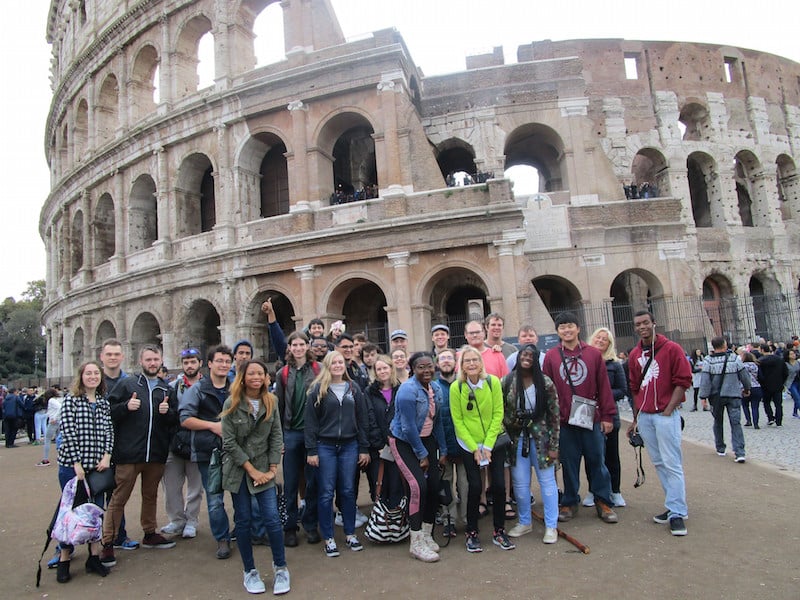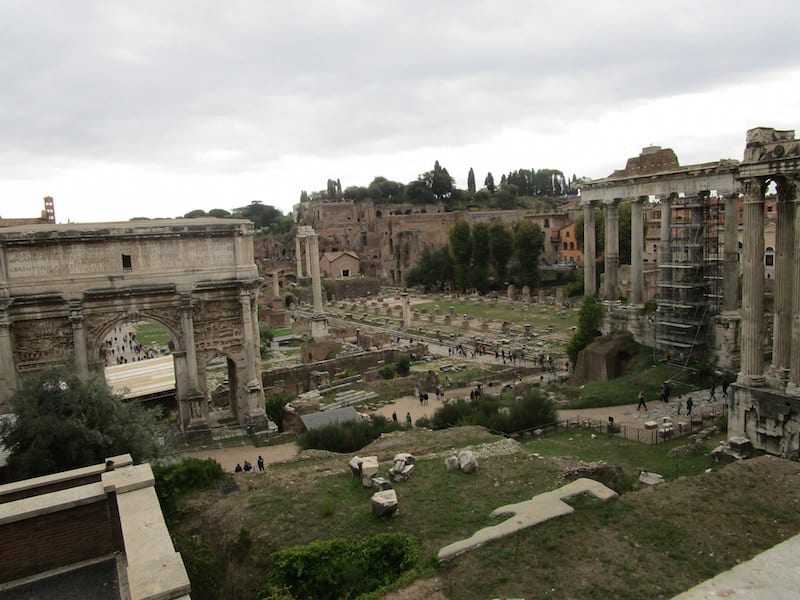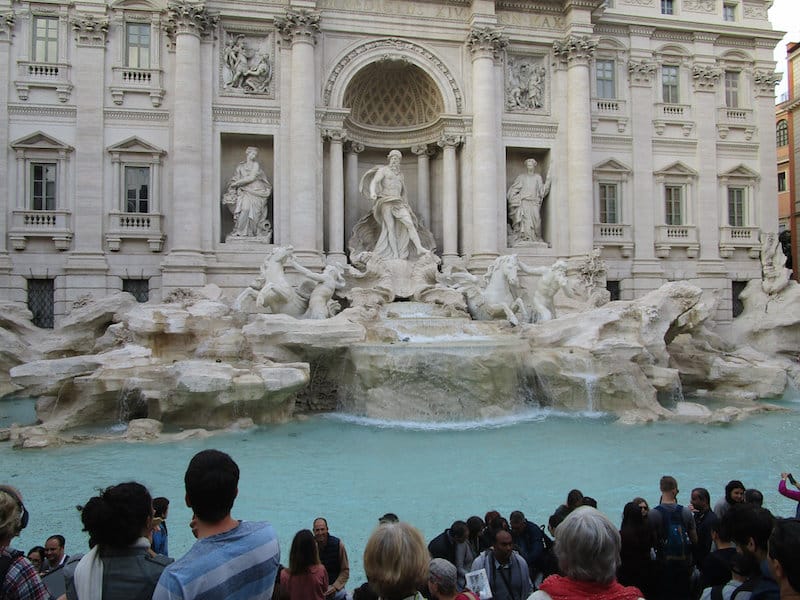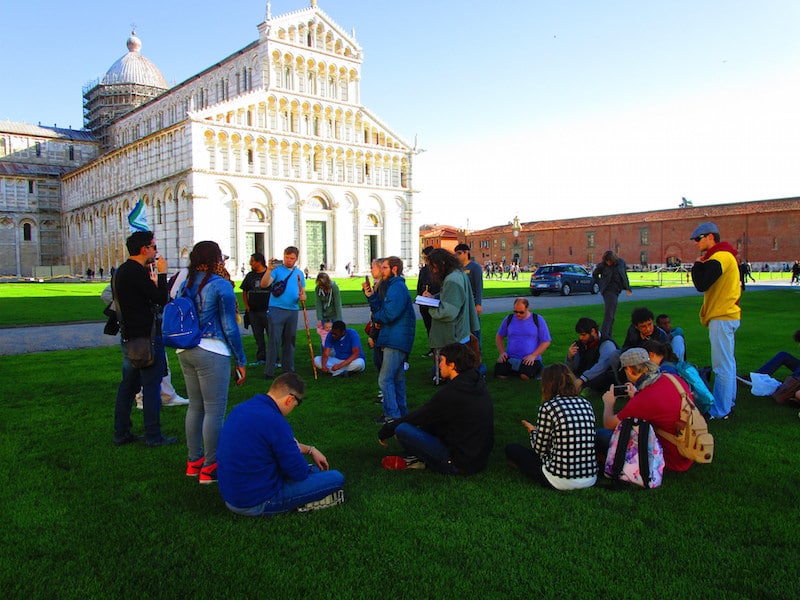Rome: Day I

We set off to see some of the high points within walking distance of our hotel. The weather was mild and the city was crowded – but nothing like it must be during the height of the tourist season. After viewing the exterior of the Basilica of Santa Maria Maggiore (we would return to see the interior later in our stay) owned by the Vatican but not in its territory, we traveled on to see the Trevi Fountain which was exceedingly crowded with those who were eager to toss a coin and make a wish – including us. I am sure many of you have received photos of coin tossing. The fountain is very beautiful and dramatically more so at night when it is lit. Several of our group returned to see it once the daytime crowds had subsided. Next we arrived at the Spanish Steps, so named because they were built in the 18th century to link the Spanish Embassy with the Trinita dei Monti church located above.
These iconic locations were made famous in several American movies such as Roman Holiday (Audrey Hepburn and Gregory Peck) The Roman Spring of Mrs. Stone (Vivien Leigh and Warren Beatty) and The Talented Mr. Ripley (Matt Damon, Gwyneth Paltrow and Jude Law) The steps themselves were not actually visible because of the crowd but the view of the church at the top was spectacular. We ended our first day at the Piazza del Popolo – the People’s Square. The name actually comes from the poplar trees that were part of the architectural and landscape design. Once the site of public executions, this large pedestrian plaza has at its center an obelisk that was brought to Rome from Egypt in 10 BC and is one of the tallest in the city. In the Northeast corner is the church of Santa Maria del Popolo. The piazza was redesigned in the 19th century linking it by steps to the Pincian Hill of ancient Rome.
Rome: Day II

Not far from the Colosseum is the Forum. This hub of ancient Roman life has an incredible number of ruins showing where the temples, palaces, government buildings and centers of political activity were located starting 8 centuries before the birth of Christ to 500 years after his death.
Moving on we came upon Trajan’s Market – the world’s oldest shopping mall and apartment buildings. The ruins reveal a large complex of arcades and offices with apartments above probably built around 100 AD by the Emperor Trajan.
We next visited the Altare della Patria (Altar of the Fatherland). This huge ornate structure is quite modern by Roman standards since it was completed less than 100 years ago (1925). Although its statuary and ornament mirrors much of what we have seen in ancient structures, this monument is a tribute to honor Victor Emmanuel who was the first king of unified Italy. Just behind this massive structure we saw, but did not enter, the 12th century Basilica of St. Mary of the Altar of Heaven located at the summit of the Capitoline Hill, one of the seven hills of Rome. This church, housing relics from Saint Helena, Constantine’s mother, is still used by Rome’s city council.
After visiting several more sites containing ruins and beautiful piazzas we ended the formal tour with a look at the Mouth of Truth (Bocca della Verita). This large stone mask is located in the portico of the church of Santa Maria in the Cosmedin. Legend has it that if you put your hand in the mouth of the sculpture and tell a lie, it will take your hand off. It is a major plot device in the 1953 movie mentioned earlier, Roman Holiday. We all walked away with hands intact. The rest of the day was for individual wandering.
Rome: Day III
Day 3 was Vatican day! It was a long walk to the Vatican complex and when we arrived, we got in line for St. Peter’s Basilica. This gave us a great opportunity to study the huge piazza in front of the church and to hear additional information and history from our guide, Silvia. Many students did not realize that once on Vatican property, we had entered another country – no need for passports, however. After about an hour we were able to enter St. Peter’s and there are really no words that can do justice to the magnificence and grandeur of the interior of the world’s largest church. One could spend days and even weeks inside and still not see everything. One very notable sculpture is Michelangelo’s Pieta. I am certain that the students will share dozens of photos of this massive and stunning structure. Built by the Emperor Constantine in 320 AD and expanded in the 15th century, the enormous dome was designed by Michelangelo. The basilica houses 140 statues of saints and 100 tombs of popes, emperors and other people of note. And that is just the beginning. We did not visit Michelangelo’s Sistine Chapel as a group but made time available for those who wanted to linger and prolong their Vatican visit.
Rome: Day IV

We visited and learned about several churches, monuments and piazzas on our way to visiting the last of the truly iconic sites on our tour: the Pantheon (Temple of every god). This amazing structure does not present a terribly imposing view from the outside, however, it is an architectural masterpiece. This former Roman temple, later a church, was built on the site of an earlier temple in about 113 AD and completed in about 126 AD. The most astounding characteristic of this structure is the coffered concrete dome with its large opening at the top: the oculus. There are no windows in the building so the oculus is the only source of natural light. The height of the oculus and the diameter of the circular interior are the same – 142 feet. The Pantheon has been in continuous use, first as a pagan temple and, since the 7th century, as a church, throughout its history. This was a fitting end to our Roman tour. The rest of the day was free time to wander, revisit, shop and eat. The next morning we were back on the train and arrived in Prato in time for a late lunch.
This trip included so many sites – if I have neglected to mention any important ones, I apologize.
Lucca
A scheduled train strike interfered with our plans, so we decided to combine visits to two places, Lucca and Pisa, and book a bus. We traveled to Lucca where we were met by a local tour guide (Davide) who led us on a walking tour of this really lovely medieval walled city. Lucca is an ancient Etruscan location and became a Roman settlement about 200 years before the birth of Christ. The first stop was at the Piazza San Michele which is where the ancient Roman forum was located. The church located there has a very different look from others we have seen around Tuscany. The façade has tiers of arches with sculptures and ornate columns. Absent is the green Prato marble evident in so many Tuscan churches. Inside are works by della Robbia and Filippino Lippi. Perhaps Lucca’s most famous son is Giacomo Puccini, composer of such enduring operas as Tosca, La Boheme and Madame Butterfly.
We passed by his statue on our way to the Piazza dell Anfiteatro, site of the ancient Roman amphitheater. This elliptical space has 4 gateways that served as access to the city for processionals, visiting dignitaries and returning military. Today the ancient amphitheater is surrounded by shops restaurants and apartments. Some of our group climbed to the top of the Guinigi Tower (the other tower in Lucca is the Clock Tower which is closed to the public at present) for a spectacular view of the city and surrounding countryside.
Pisa

The upper floor of the Bapistry offered magnificent views of the entire complex and immediate countryside including the ancient walls. The Camposante Monumentale, monumental cemetery, has been the resting place of many prominent Pisans since it was built in the 13th century and legend has it that it is holy ground since it was built around a shipload of sacred soil from Golgotha (site of Christ’s crucifixion), brought from the Holy Land by the archbishop of Pisa in the 12th century. The floors are covered in individual grave markers and the walls of the portico are lined with stone sarcophagi.
The 12th century Tower is simply beautiful. It is so iconic that it is hard to believe that it is even real. That it leans goes without mentioning – however, it is not as well known that the other structures in the complex lean as well – it is just not as obvious. Some of our group paid to climb to the top and experienced a strange vertigo from climbing at an angle, others were satisfied with the exterior view. The leaning began during construction due to soft ground beneath the foundation and was never completely corrected. It was quite a sight against the brilliant blue of the Tuscan afternoon sky.
We are approaching the end of our Tuscan journey and there will not be many more posts. Hoping that these submissions have been informative and illustrative. The students will be able to fill in any blanks and regale you with personal stories and observations – I hope for years to come.
– Andrea Brode